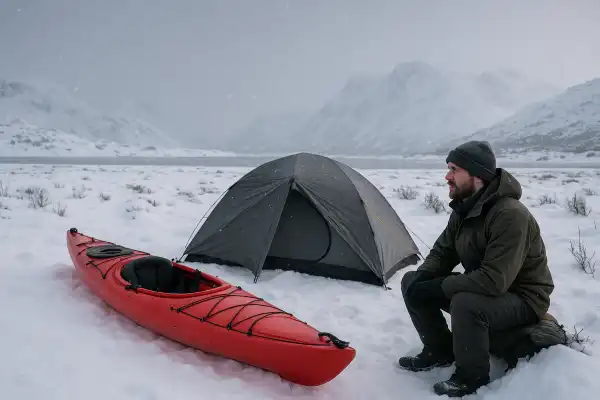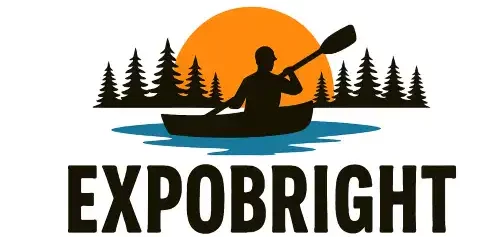Where can you kayak camp in Alaska becomes the burning question for paddlers the moment they catch their first glimpse of the Last Frontier’s dramatic coastline. The sheer scale of options can feel overwhelming—from glacier-carved fjords to protected marine parks scattered across thousands of miles of wilderness shoreline.
During my early expeditions along Alaska’s coast, I learned that choosing the right location makes the difference between a good trip and an unforgettable one. Each region offers distinct experiences, from the iceberg-studded waters of Prince William Sound to the towering granite walls of Southeast Alaska’s fjords.
Must read for your safety when kayak camping: How to get rid of spider in a kayak?
Where can you kayak camp in Alaska?
Alaska offers some of the world’s greatest sea kayaking locations, with glaciers, icebergs, wild fjords, and abundant wildlife creating unparalleled wilderness experiences along its vast coastline. The best kayak camping destinations span three primary regions: Prince William Sound in Southcentral Alaska, Southeast Alaska’s Inside Passage, and the Kenai Peninsula.

Prince William Sound
Prince William Sound stands as Alaska’s premier kayak camping destination, offering protected waters, numerous glaciers, and established camping areas accessible by water taxi. This massive sound provides paddlers with everything from beginner-friendly protected coves to challenging open-water crossings.
Columbia Bay and Heather Bay offer spectacular camping near the largest tidewater glacier in Prince William Sound. Columbia Glacier creates a massive floating icefield with towering icebergs, while Heather Bay provides access points and camping areas for multi-day expeditions. The granite coves around Glacier Island serve as excellent base camps for exploring sea lion colonies and watching for marine mammals.
Blackstone Bay presents one of the most dramatic camping environments in the sound. Water taxis commonly drop paddlers at Willard Island, where you can establish camp and spend days exploring multiple glaciers including the often-calving Surprise Glacier. The bay’s protected waters make it suitable for intermediate paddlers.
Shoup Bay State Marine Park near Valdez offers the unique advantage of road accessibility combined with wilderness camping. Paddlers can camp directly in front of Shoup Glacier and explore the waterfall-laden coastline, making it perfect for shorter trips or those wanting easier logistics.
Culross Passage provides a classic multi-day paddling corridor. This protected passage allows paddlers to move camp progressively, spending 4-5 miles paddling each day while experiencing diverse coastal environments. The passage connects to Port Nellie Juan, extending options for longer expeditions.
Additional established camping areas include Olsen Island with well-established forest campsites, Cascade Bay Campsite with waterfall views, and Crafton Island offering spectacular overhanging cliffs and caves.
Southeast Alaska’s Inside Passage
Southeast Alaska’s protected waterways offer world-class kayak camping among temperate rainforests and massive tidewater glaciers.
Glacier Bay National Park represents the pinnacle of Alaskan kayak camping. Experienced campers can rent kayaks for independent adventures, with the West Arm providing pristine wilderness camping near Reid, Lamplugh, and John Hopkins Glaciers. The remote upper fjords offer dramatic mountain scenery and calving glaciers, though paddlers should expect camping on beaches rather than in forests.
Misty Fjords National Monument near Ketchikan provides over 2 million acres of designated Wilderness Area. This monument features 3,000-foot sheer cliff fjords, 13 public-use cabins, and five shelters accessible by kayak. The fjords reward paddlers with hot springs, pictographs, and Forest Service cabins, along with dramatic granite walls rising directly from the water.
Icy Bay in the panhandle area near Yakutat offers truly remote kayak camping. Despite being less accessible than other locations, Icy Bay provides world-class sea kayaking with views of the highest coastal mountains, four massive glaciers, and some of the most remote landscapes on Alaska’s coastline.
Kenai Peninsula and Kenai Fjords National Park
The Kenai Peninsula combines accessibility with pristine wilderness, making it ideal for both novice and experienced kayak campers.
Northwestern Fjord in Kenai Fjords National Park offers the most dramatic kayak camping on the peninsula. This newly revealed landscape, covered by glaciers less than 100 years ago, features calving tidewater glaciers, icebergs, and glacially scarred granite walls. The fjord provides true wilderness camping on rocky beaches with opportunities for wildlife watching and photography.
Aialik Bay serves as a more accessible introduction to Kenai Fjords camping. Water taxis from Seward provide easy access to rocky beach camping areas, with opportunities to paddle among icebergs and observe abundant marine wildlife. The bay also features public-use cabins including Aialik Bay Cabin and Holgate Cabin, offering spectacular views of Holgate Glacier.
Resurrection Bay around Seward provides gentler kayak camping options. Multi-day adventures in this bay offer mountain and ocean vistas with common sightings of smaller marine mammals, making it suitable for those new to Alaska kayak camping.
State Marine Parks and Protected Areas
Alaska’s state marine park system includes eight parks in Prince William Sound and three near Valdez, providing boaters and kayakers with protected anchorages and designated camping areas. Key locations include:
- Ziegler Cove and Surprise Cove with established campsites and picnic facilities
- South Esther Island offering camping and a public-use cabin at Decision Point
- Shoup Bay, Sawmill Bay, and Jack Bay surrounding Valdez with road or water access
Planning Considerations
Prince William Sound and other Alaska waters can change from glassy calm to turbulent conditions quickly, with tidal swings ranging from -2 to 24 feet. The best time for kayak camping falls between mid-May and mid-June to avoid crowds and mosquitoes, with late August and September offering another window despite more unpredictable weather.
Most remote locations require water taxi access from towns like Whittier, Valdez, Seward, or Ketchikan. For unguided parties, no permits are required for sea kayaking in Prince William Sound since it’s part of the United States Forest Service land, though guides need permits for commercial operations.
Conclusion
Last September, I guided a family through a four-day expedition in Blackstone Bay, watching their amazement grow as we paddled between icebergs the size of houses. By trip’s end, their initial nervousness had transformed into confidence, proving how the right location and proper guidance can unlock Alaska’s incredible kayak camping opportunities. Whether you choose the glacier-carved fjords of Prince William Sound or the protected waters of Southeast Alaska, following a well-researched plan makes the difference between merely visiting Alaska and truly experiencing its wild heart from the intimate perspective of a kayak camp.
Follow Expobright for exclusive kayak and canoe camping tips.
